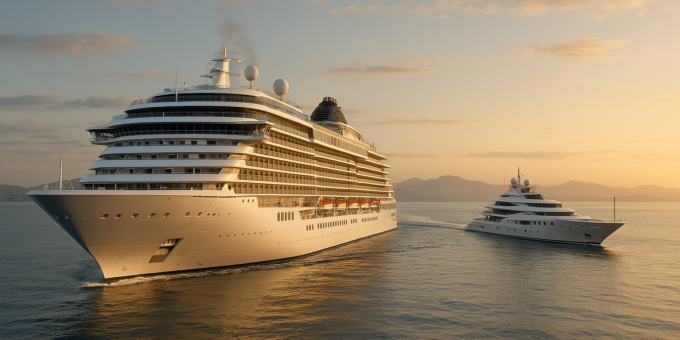
The tides of wealth are shifting—quite literally. In an era where privacy is paramount, experiences trump possessions, and alternative investments are flourishing, luxury ships have emerged as floating fortresses of fortune. The future of high-end maritime investment isn’t a fleeting fantasy of the elite; it’s a flourishing asset class driven by innovation, exclusivity, and untapped economic potential.
Investors once dazzled by penthouse apartments and rare art are now anchoring their funds into the deep blue—where luxury ships offer both lifestyle and lucrative returns. Whether through ownership, chartering, or syndicate models, these vessels present an alluring frontier. From multi-deck superyachts to technology-infused expedition ships, the industry sails confidently toward a future brimming with opportunity.
High-End Maritime Investment Luxury Ships
Investing in luxury ships isn’t merely about indulging in extravagance; it’s about acquiring an asset that offers unparalleled access, freedom, and exclusivity. These maritime masterpieces, often stretching well over 100 meters, feature amenities like helipads, onboard cinemas, infinity pools, and private submarines. Some even rival five-star resorts in sophistication.
In 2024, industry reports indicate that the global superyacht market crossed $12 billion, with projections suggesting a $17 billion valuation by 2030. And why not? As terrestrial luxury becomes increasingly accessible, the elite are looking seaward to differentiate and diversify. High-net-worth individuals (HNWIs) view luxury vessels not just as lifestyle purchases, but as tools for portfolio expansion.
Understanding Luxury Ships as Investment Assets
Luxury vessels are classified by size, build, and purpose. They range from:
-
Superyachts (24-60 meters): Ideal for private use and high-end charters.
-
Megayachts (60-100+ meters): Ultra-exclusive vessels with extensive staff and facilities.
-
Expedition yachts: Built for long-range travel, often with ice-class hulls and submarines.
-
Eco-yachts: Sustainable designs with hybrid engines, solar sails, and zero-waste systems.
Unlike cars or standard boats, luxury ships retain or even appreciate in value depending on pedigree, build quality, and innovation. They also yield income via chartering or fractional ownership models, making them dynamic investment vehicles.
Historical Evolution of Maritime Investment
Historically, maritime investments were rooted in commerce—think merchant fleets and cargo ships. But with the 20th-century rise in leisure wealth and technology, the tides turned. The 1980s marked the arrival of private yachts as symbols of success, yet today’s maritime assets are strategic investments with performance metrics.
Jeff Bezos’ 417-foot megayacht “Koru” sparked renewed investor interest in 2023, reminding the world that the ocean is not just a playground but a proving ground.
Why the Ultra-Wealthy Are Investing in the Seas
Privacy. Security. Flexibility. And let’s not forget the undeniable allure of status. For the ultra-wealthy, luxury yachts serve as mobile sanctuaries. They allow travel without borders, offer tax-efficient structuring, and deliver unparalleled lifestyle access.
Moreover, a yacht isn’t just a floating hotel—it’s a floating asset. Its customizability and charterability make it monetizable, enhancing its ROI and value proposition.
High-End Yacht Ownership vs. Chartering
Ownership provides control, status, and complete personalization. However, it’s not without costs—maintenance can run 10-15% of the vessel’s purchase price annually. That’s where chartering steps in.
Chartering offers exposure without responsibility. You can earn $200K to $1M per week by chartering your yacht during off-seasons. Many owners offset operating costs by leveraging this strategy, and with modern yacht management firms, it’s hassle-free.
Superyachts and Megayachts: Defining the Difference
While both evoke grandeur, the distinction is significant. Superyachts start at 24 meters and are opulent yet manageable. Megayachts exceed 100 meters, often boasting multiple helipads, submarines, medical centers, and private beaches. These giants are floating ecosystems, demanding full-time crews and corporate-level logistics.
Economic Impact of Luxury Shipbuilding
Luxury shipbuilding fuels economies across Europe, the U.S., and Asia. Italy’s Ferretti Group, Germany’s Lürssen, and the Netherlands’ Oceanco lead the pack. Each superyacht sustains hundreds of skilled jobs—from naval architects to chefs and engineers.
Additionally, maritime tourism sees a spillover. Ports, marinas, and nearby luxury resorts benefit immensely from yacht visits, revitalizing local economies.
Technological Innovation in Luxury Ships
Today’s vessels are marvels of engineering. From AI-powered navigation systems to retractable decks and underwater lounges, tech transforms the user experience. Expect:
-
Hydrogen-fueled propulsion
-
Autonomous cruising systems
-
Starlink satellite internet for global connectivity
-
Biometric security systems
This fusion of technology and luxury ensures the asset remains future-proof.
Top Destinations for Luxury Maritime Travel
Elite travelers chart courses to:
-
Mediterranean: Monaco, Amalfi Coast, Santorini
-
Caribbean: St. Barts, Virgin Islands, Antigua
-
Asia-Pacific: Maldives, Thailand, Fiji
-
Arctic & Antarctic Expeditions: For eco-luxury and untouched beauty
Each port offers not just beauty but geopolitical stability and strategic tax zones.
FAQs
What defines a luxury ship as an investment?
It’s a vessel built not just for pleasure, but for value appreciation, charter income, and alternative wealth diversification.
Can you make a profit by chartering a luxury yacht?
Yes, owners often earn substantial revenue, especially during high seasons, offsetting operational costs significantly.
How do eco-friendly luxury ships work?
They use hybrid propulsion, renewable energy sources, and sustainable materials to reduce emissions and oceanic impact.
Are luxury ships affected by economic downturns?
They’re relatively resilient due to the ultra-wealthy’s stable asset base, but market appetite for chartering may fluctuate.
How much does it cost to maintain a megayacht annually?
Expect to pay 10–15% of the vessel’s initial value each year for crew, fuel, maintenance, insurance, and docking.
Can cryptocurrency be used to buy or invest in luxury ships?
Yes, several brokerages and builders accept crypto payments, and blockchain is enabling tokenized ownership.
You Can Also Read : Is Buying a Luxury Ship a Good Investment? Here’s What to Know
The future of high-end maritime investment through luxury ships is anything but adrift. It’s a booming, tech-driven, and ultra-exclusive market where innovation meets opulence. From sustainability to digitalization, the industry is redefining what it means to invest and escape—at once.
In a world crowded by conformity, these floating empires offer sovereignty, legacy, and return potential. And for those with the vision to navigate these waters, the horizon promises not just sunsets, but substantial financial sunrises.
